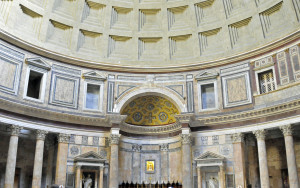
Interior of Pantheon in Rome (Photo by Don Knebel)
In about 126 A.D., Roman Emperor Hadrian completed a temple on the spot where tradition said Romulus, Rome’s mythical founder, had ascended to the heavens, the domain of the gods. The building comprised a dome-topped cylindrical rotunda entered through a colonnaded Greek-style portico. The 142-foot diameter of the spherically-shaped dome duplicated its height, so if the dome were turned upside down its top would touch the floor. The self-supporting dome was made entirely of concrete, decreasing in both thickness and density further toward the top. The apex of the dome was open, creating a 27-foot diameter oculus ringed in bronze.
Hadrian named the temple “Pantheon,” meaning “all the gods.” The underside of the dome symbolized the heavens. Light streaming through the oculus on sunny days progressed around the polished marble interior. Drain pipes along the perimeter of the floor collected rainwater falling through the oculus. Niches along the curved walls held statues of Roman gods and emperors.
Brunelleschi, who designed the famous dome of the Florence Cathedral in the fifteenth century, was inspired by the Pantheon, which had become a church in 609. But the secrets of the Pantheon’s design had long been forgotten, so Brunelleschi was forced to use reinforcing chains in his similarly-sized dome. When Michelangelo saw the Pantheon in about 1500, its unreinforced dome still intact, he declared its design the work of angels.
Michelangelo and Brunelleschi were not alone in admiring Rome’s Pantheon. Thomas Jefferson mimicked its design for the Rotunda at the University of Virginia. The Pantheon also inspired the domed center section of Jefferson’s home at Monticello, which has been on the reverse of all nickels since 1938.
Comments are closed.